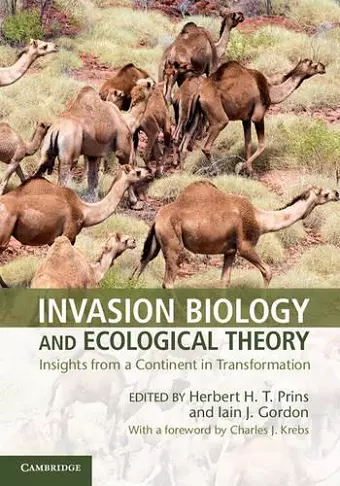Invasion Biology and Ecological Theory
Insights from a Continent in Transformation
Herbert H T Prins editor Iain J Gordon editor
Format:Hardback
Publisher:Cambridge University Press
Published:23rd Jan '14
Currently unavailable, and unfortunately no date known when it will be back

A critical appraisal of ecosystem theory using case studies of plant and animal invasions in Australasia.
This book examines ecosystem theory in the context of invasive species, evaluating its reliability in making predictions about the likely effects of new species on particular habitats. The authors use case studies of ancient and modern biological invasions in Australasia, ranging from Acacias and water birds to rabbits and dingoes.Many conservationists argue that invasive species form one of the most important threats to ecosystems the world over, often spreading quickly through their new environments and jeopardising the conservation of native species. As such, it is important that reliable predictions can be made regarding the effects of new species on particular habitats. This book provides a critical appraisal of ecosystem theory using case studies of biological invasions in Australasia. Each chapter is built around a set of eleven central hypotheses from community ecology, which were mainly developed in North American or European contexts. The authors examine the hypotheses in the light of evidence from their particular species, testing their power in explaining the success or failure of invasion and accepting or rejecting each hypothesis as appropriate. The conclusions have far-reaching consequences for the utility of community ecology, suggesting a rejection of its predictive powers and a positive reappraisal of natural history.
'This book represents a novel and exciting approach to testing some fundamental ecological ideas such as the niche concept, competition, disturbance, and life history strategy. It does so using invasive alien species, with Australia as both the invaded environment, as well as the source of the invasives. The approach taken is to propose a series of ecological hypotheses and test these against invader case studies ranging from the failed (finches) to the downright spectacular (water buffalo in Northern Australia). A series of specialist authors tackles each case study, before the editors, Prins and Gordon, conclude with a synthesis chapter that reviews the evidence for and against each hypothesis, drawing on each author's findings in a structured way. The principal intent of this book is to inform the science of ecology, but it is rich in valuable insights to those grappling with the management of this great threat to global biodiversity.' Mark Lonsdale, Commonwealth Scientific and Industrial Research Organisation, Canberra
'This book is both a reasoned call to action and a healthy antidote to hubris. Prins and Gordon assembled a team of authors to examine the history of biological invasions in Australia and undertake a bold test of what we think we know about invasion biology. They distilled that body of theory into eleven hypotheses about invasions in general, and each author tested the hypotheses independently using different historical and recent examples. Have a stiff drink ready for when you finish this book because it will shake your confidence in the idea that conservationists can or even should try to make predictions based on ecological theory. This is not as nihilistic a conclusion as might be assumed though because they also found the fate of invasive biota likely does not seem to simply be determined by chance either.' Conservation Biology
ISBN: 9781107035812
Dimensions: 253mm x 180mm x 33mm
Weight: 1110g
540 pages